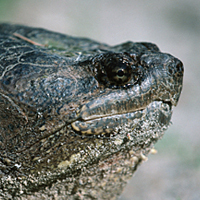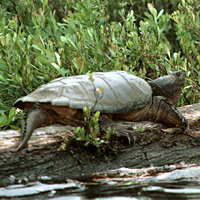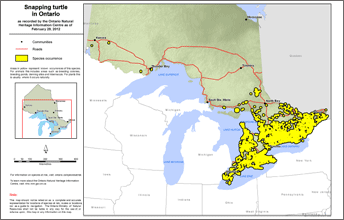Snapping turtle
Scientific name: Chelydra serpentina




Cover photos credit: Wasyl Bakowsky (left), J.D. Taylor (middle-left, middle-right and right)
Status
Special Concern
"Special Concern" means the species lives in the wild in Ontario, is not endangered or threatened, but may become threatened or endangered due to a combination of biological characteristics and identified threats.
Date added to the Species at Risk in Ontario List
September 10, 2009
What it looks like
The Snapping Turtle is Canada’s largest freshwater turtle, reaching an average length of 20-36 cm and a weight of 4.5-16.0 kg. Snapping turtles have large black, olive or brown shells typically covered in algae. Their tails, which can be longer than their bodies, have dinosaur-like triangular crests along their length. Hatchlings are about the size of a loonie and are smaller and darker than adults, with pronounced ridges along the length of their shell.
Where it lives
Snapping Turtles spend most of their lives in water. They prefer shallow waters so they can hide under the soft mud and leaf litter, with only their noses exposed to the surface to breathe.
During the nesting season, from early to mid summer, females travel overland in search of a suitable nesting site, usually gravelly or sandy areas along streams. Snapping Turtles often take advantage of man-made structures for nest sites, including roads (especially gravel shoulders), dams and aggregate pits.
Where it’s been found in Ontario
The Snapping Turtle’s range extends from Ecuador to Canada. In Canada this turtle can be found from Saskatchewan to Nova Scotia. It is primarily limited to the southern part of Ontario. The Snapping Turtle’s range is contracting.
View a larger version of this map (PDF)
What threatens it
It takes 15 to 20 years for a Snapping Turtle to reach maturity. As a result, adult mortality greatly affects the species' survival. During the summer, many turtles cross roads in search of mates, food and nest sites. This is risky for turtles as they are too slow to get out of the way of moving vehicles. Snapping turtles are also sometimes intentionally persecuted. Eggs in nests around urban and agricultural areas are subject to predators such as raccoons and striped skunks.
Action we are taking
Special concern species do not receive species or habitat protection.
What you can do
Report a Sighting
- the Ministry of Natural Resources and Forestry tracks species at risk; you can use a handy online form to report your sightings to the Natural Heritage Information Centre; photographs with specific locations or mapping coordinates are always helpful
- every year, turtles all over the province cross busy roads to get to their nesting sites, or use gravel shoulders of roads as nesting sites; watch for turtles on the roads, especially between May and October
- the Ontario Reptile and Amphibian Atlas also collects observations of all Ontario reptiles and amphibians. Submit your observations at: www.ontarionature.org/atlas.
Volunteer
Volunteer with your local nature club or provincial park to participate in surveys or stewardship work focused on species at risk.
Be a good steward
- private land owners have a very important role to play in species recovery; you may be eligible for stewardship programs that support the protection and recovery of species at risk and their habitats
- as with many other rare plants and animals, the Snapping Turtle depends on wetland habitat; you can help by protecting any wetlands and surrounding natural vegetation on your property
- visit the Ontario Reptile and Amphibian Atlas (www.ontarionature.org/atlas) or Toronto Zoo Adopt-a-Pond website (www.torontozoo.com/Adoptapond) to learn more about Ontario’s turtles.
Report illegal activity
Report any illegal activity related to plants and wildlife to 1-877-TIPS-MNR (847-7667).
Quick facts
- the Snapping Turtle spends so much time underwater that algae grow on its shell; this helps them blend in with their surroundings
- Snapping Turtles are believed to live well over 100 years
- the sex of hatchlings varies depending on the temperature that eggs are incubated at; eggs that are kept at a temperature of 23-28°C hatch male turtles; eggs incubated at other temperatures hatch into females
